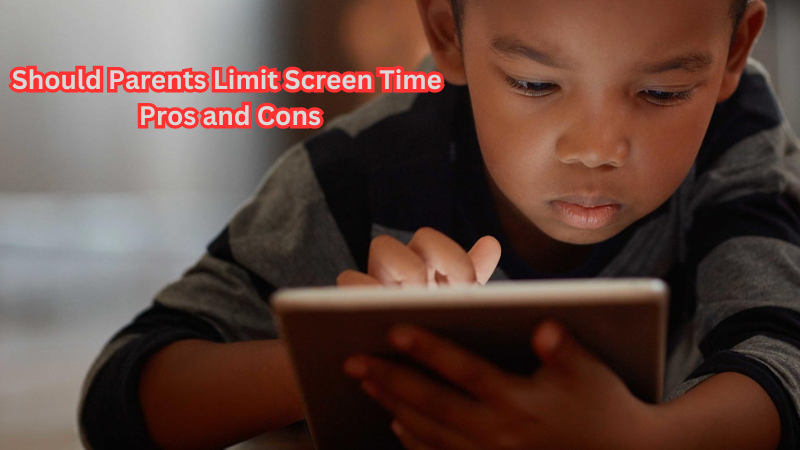In today's digital age, screens have become integral to children's lives, from educational tools to entertainment hubs. As the prevalence of screen time continues to rise, it becomes crucial for parents to understand its profound impact on their children.
While screens offer numerous benefits, such as access to information and learning resources, they pose potential risks, including physical health issues and social isolation. This blog post aims to delve into both the advantages and disadvantages of limiting screen time, providing a balanced perspective to help parents make informed decisions.
Join us as we explore the various facets of this important topic and seek to find a healthy balance for our children.
What is Screen Limit?
Screen limit refers to the time a child spends in front of a screen, including television, computers, tablets, and smartphones.
With the increasing availability of screens and their multiple uses, it has become challenging for parents to set strict limits on their children's screen time. However, parents must understand that excessive screen time can have adverse effects on their child's physical and mental well-being.
Screen limit also includes regulating the content that children consume through these devices as it can greatly impact their development. As such, setting boundaries and being mindful of how much time children spend on screens is essential in today's digital world.
Importance of Screen Time Management
Screen time management is crucial for maintaining a healthy balance in children's lives.
While screens offer many benefits, excessive screen time can have detrimental effects on their development. Studies have shown that too much screen time can lead to physical health issues such as obesity, poor posture, and eye strain. It can also affect their mental health by causing anxiety, depression, and sleep disturbances.
Moreover, limiting screen time allows children to engage in other activities such as outdoor play, creative playtime, and spending quality time with family and friends. These activities are essential for their social and emotional development.
Therefore, managing screen time not only helps prevent potential risks but also encourages a well-rounded upbringing for children.
Why Should Parents Limit Screen Time: Pros and Cons
Now that we have established the definition and importance of screen limit, let's delve into the pros and cons of limiting screen time for children.
Pros of Limiting Screen Time
Promotes physical activity
One of the significant advantages of setting a screen time limit is that it encourages children to engage in physical activities. It is no secret that excessive screen time leads to a sedentary lifestyle, which can have severe consequences on a child's health. By limiting screen time, parents can motivate their children to be more physically active, promoting overall well-being.
Furthermore, outdoor play and sports not only contribute to physical health but also improve social skills and teamwork.
Enhanced Academic Performance
While screens have become an integral part of education, too much screen time can also have adverse effects on a child's academic performance. Research has shown that limiting screen time allows children to focus more on their studies and improve their grades. It also reduces the likelihood of distractions and procrastination, leading to better time management skills.
Encourages Face-to-Face Interaction
Another significant advantage of limiting screen time is that it encourages face-to-face interaction with family and friends. Excessive screen time can lead to social isolation and hinder a child's ability to develop essential communication skills. By setting boundaries for screen use, parents can promote healthy relationships and help children develop strong interpersonal skills.
Protects Children from Inappropriate Content
With the vast amount of information available on the internet, it becomes challenging for parents to monitor their children's online activities continuously. By setting a screen time limit, parents can protect their children from exposure to inappropriate content that may harm their mental and emotional well-being.
Increased Creativity and Imagination
Limiting screen time also allows children to engage in creative playtime and develop their imagination. With screens dominating most of our lives, it has become challenging for children to think outside the box and come up with their ideas. By reducing screen time, parents can encourage their children to use their creativity and imagination, leading to holistic development.
Cons of Limiting Screen Time
Resistance from Children
One of the challenges that parents may face when limiting screen time is resistance from their children. Children have become accustomed to using screens for entertainment and may not appreciate sudden restrictions on their screen time usage. As such, it requires patience and effective communication from parents to help them understand the importance of limiting screen time.
Difficulty in Monitoring
With the widespread use of screens, it may become challenging for parents to monitor their children's screen usage effectively. Children may have access to multiple devices, making it easier for them to sneak in additional screen time. Additionally, with the increasing number of online classes and educational resources available on screens, it becomes crucial for parents to strike a balance between beneficial and excessive screen use.
Alternative Solutions
While limiting screen time is essential, it is not the only solution that can be implemented. Parents can also opt for alternative solutions such as setting a specific schedule or using parental control apps to monitor and restrict their children's screen usage. Parents need to find a balance that works for their family and adhere to it consistently.
Open Communication
Effective communication is key in helping children understand the importance of limiting screen time. Parents should have open and honest conversations with their children about the potential risks of excessive screen time, but also explain why screens can be beneficial when used in moderation.
This will not only help children understand the reasoning behind screen time limits but also foster trust and understanding between parents and children.
Reduced Digital Literacy
Another potential disadvantage of limiting screen time is that it may reduce a child's digital literacy skills. In today's digital world, having a good understanding and proficiency in using technology is crucial for future success. By limiting screen time, children may miss out on opportunities to develop their technological skills and keep up with the rapidly evolving digital landscape.
However, this can be overcome by finding a balance between screen time limits and incorporating educational activities involving screens into a child's routine.
These are just some of the pros and cons of limiting screen time for children. Ultimately, it is up to parents to make informed decisions based on what works best for their child's well-being and development.
Guidelines for Limiting Screen Time
Here are some general guidelines that parents can follow to limit their children's screen time effectively:
- Set a specific daily or weekly screen time limit for each child, taking into consideration their age and individual needs.
- Encourage alternative activities such as outdoor play, reading, and creative playtime to reduce the dependence on screens for entertainment.
- Establish screen-free zones in the house, such as during mealtimes and before bedtime, to promote quality family time and better sleep habits.
- Use parental control apps or features available on devices to monitor and restrict screen usage.
- Lead by example and limit your screen time usage. Children often imitate their parent's behavior, so it is essential to set a good example.
- Have open and honest conversations with your children about the importance of limiting screen time and the potential risks of excessive use.
Remember, every child is unique, and there is no one-size-fits-all approach when it comes to limiting screen time.
Age-Specific Guidelines
As children grow, their screen time requirements and usage may change. Here are some age-specific guidelines to help parents determine appropriate screen time limits for their children:
- 2-5 years old: Limit screen time to 1 hour or less per day and prioritize interactive and educational content.
- 6-12 years old: Set a limit of 2 hours or less per day, with a healthy balance of educational and recreational screen use.
- 13+ years old: Encourage responsible self-monitoring of screen time usage, but set boundaries to ensure a healthy balance between screens and other activities.
It is crucial for parents to continually reassess and adjust the screen time limits based on their child's individual needs and development.
Parental Role Modeling
Children often imitate their parents' behavior. Therefore, parents need to lead by example and limit their screen time usage.
By doing so, not only are they setting a positive example for their children to follow, but they are also prioritizing quality family time and reducing the negative effects of excessive screen use on their well-being.
Parents can also involve their children in finding alternative activities that do not involve screens and make a conscious effort to engage in them together. This will not only strengthen the parent-child bond but also promote healthy habits and reduce screen time dependency in both parents and children.
FAQs
What are the pros of limiting screen time for young kids?
Limiting screen time for young kids can encourage healthier habits and development. By reducing time spent watching videos or playing video games, parents can promote physical activity, better sleep patterns, and more face-to-face interaction with family members. It also helps in reducing exposure to blue light, which can affect sleep quality and eye health.
What are the cons of screen time for most kids?
The cons of screen time for most kids include potential negative impacts on physical health, such as poor posture and reduced physical activity. Extended periods of screen use can lead to eyestrain and disrupted sleep due to blue light exposure. Excessive screen time can also hinder social skills development and reduce time spent on other important activities like homework and family interactions.
How much screen time is considered appropriate for young kids?
The appropriate amount of screen time for young kids varies by age, but experts generally recommend no more than one hour per day for children aged 2 to 5, focusing on high-quality, educational apps and content. For older kids, setting healthy boundaries and balancing screen time with other activities is crucial to ensure overall well-being and development.
How can parents encourage kids to balance screen time with other activities?
Parents can encourage kids to balance screen time with other activities by setting clear rules and schedules. Engaging kids in alternative activities like outdoor play, reading, and family games can help. Encouraging video chatting with family members can foster social skills development, while educational apps can be integrated into screen time to make it more productive. Creating a family media plan that outlines when and how screens can be used can help establish healthy boundaries and promote a balanced lifestyle.
Conclusion
In summary, while limiting screen time has clear benefits, such as improved physical health, academic performance, and social skills, it also has potential drawbacks like social isolation and reduced digital literacy.
Striking a balance is essential to harness the advantages while mitigating the risks. Parents can manage screen time effectively by setting clear boundaries, encouraging alternative activities like outdoor play and reading, and modeling good screen habits themselves.
By doing so, they can ensure their children enjoy the benefits of technology without compromising their overall well-being. Finding this balance is key to fostering a healthy, well-rounded development for children in the digital age.





